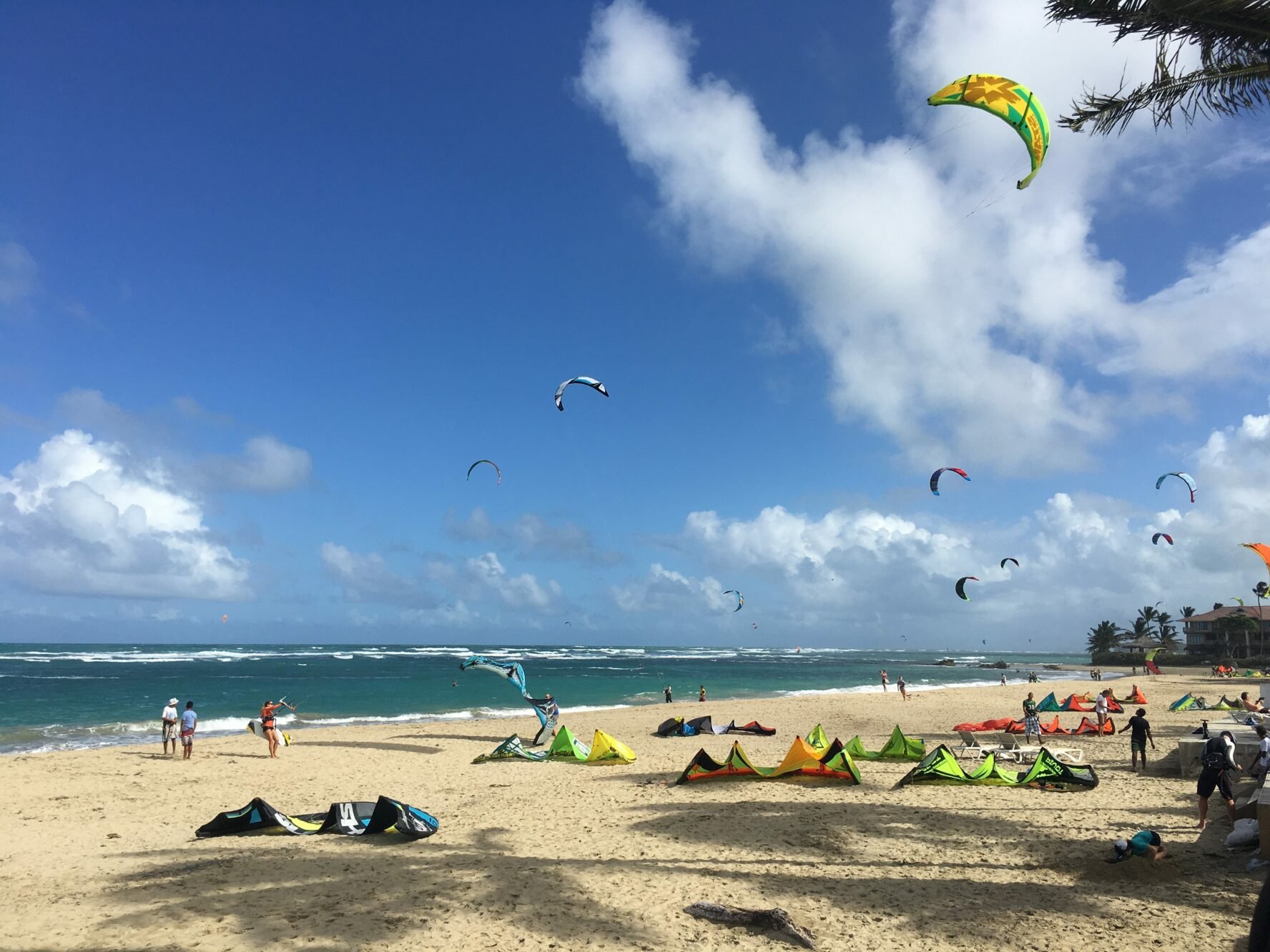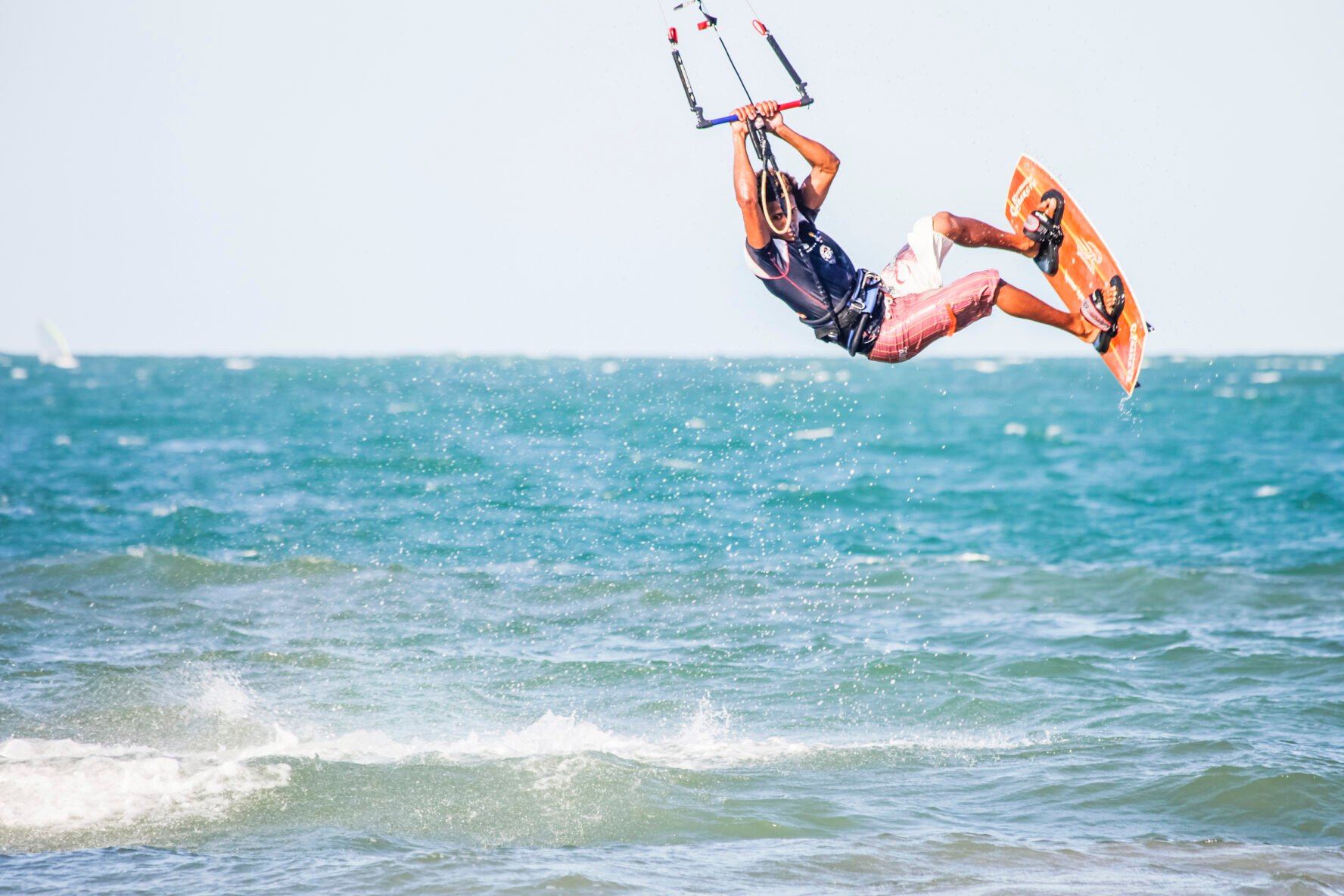I never dreamed that traveling could get any better until I started kitesurfing, chasing the wind to some of the most remote, exotic and mind-blowing locations around the world. Just as diverse as kitesurfing is with riding styles — from freestyling, foiling to wave riding — are the spots you can experience: Caribbean tropical paradises, strong wind locations where you can ride every day, spots where you party as hard as you shred on the water.
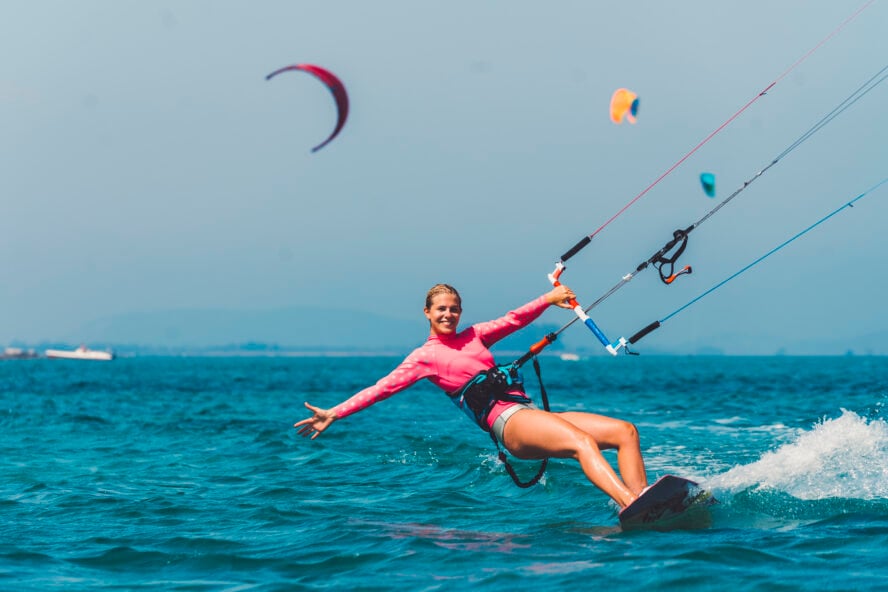
While those in the know may be familiar with the best places to kiteboard in the US, the true bucket-list spots lie well beyond these borders. Each location has its own appeal, from the water conditions to the kitesurfing culture to the activities you can do on the side. Whether you’re just starting out, looking to progress your tricks in ideal conditions, or a seasoned boarder searching for world-class waves, there’s something on this list for everyone. Here are ten of the best places around the globe for your kiteboarding tours:
1. Cabarete
Usually when picking a kitesurf spot, I have to give up on some comforts or activities I like to do besides kitesurfing, but this former fisherman’s village that has become one of the world’s most renowned watersports destinations really has it all. It ticks all the boxes for action junkies, boardsports lovers and those in need of an activity-filled vacation: kitesurfing, windsurfing, surfing, SUP Yoga, outdoor gyms with CrossFit, as well as yoga studios with ocean views are just some of the activities you can enjoy in Cabarete.
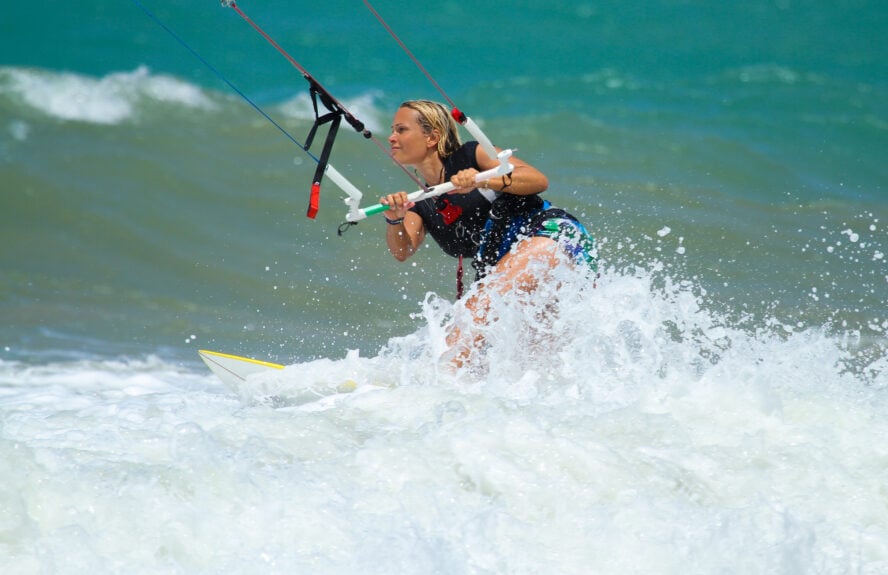
Cabarete is for all levels of riders
This spot is ideal for all levels of kitesurfing — whether you want to learn kitesurfing, want to boost higher with the small kickers that are building up on the reef, or want to ride some waves on a strapless board. For the downwind lovers, there are some nice options as well: either going from the river mouth (and tiny lagoon) La Boca to Kite Beach or going from Kite Beach to the surf spot Encuentro, which offers some beautiful waves.
Wave lovers will enjoy it more in the winter months as the swell is usually bigger while the wind is moderate. In the summer months, there’s some stronger winds with smaller waves.
Ever since my first kitesurfing trip to Cabarete, I find myself returning again and again — I even lived there for a year! No place has ever hooked me like this and it’s pretty easy to see why.
Cabarete - Good to Know
From beginners to advanced
December – April are lighter wind months, bigger swell for the surfers. June – July stronger wind months, smaller swell
Dec – Apr: around 14–24 knots; Jun – Jul:l 16–30 knots
Mostly choppy, waves on the reefs (flatwater in La Boca for advanced riders)
In winter shorty; in summer boardshorts/bikini and a rashguard for sun protection
Get Papi’s famous shrimp dish at La Casita De Papi in Cabarete
Kite Club Cafe on Kite Beach
If you have the time, do a roadtrip to Samana to see the Peninsula (go whale watching from Jan – Mar) and if it’s windy enough, kitesurf in Las Terrenas
Getting there
Flying into Puerto Plata (POP) is the fastest and easiest option, which is a convenient 20-minute cab ride from Cabarete. You can also pre-arrange your taxi with your accommodation and have your driver meet you at the airport.
2. La Ventana
It’s a bit hard to grasp the special magic that La Ventana has for me: it’s a mix of the Mexican vibes, the quietness, the welcoming community, the early morning yoga sessions (or mountain bike tours), the afternoon kite sessions with a post-kite beer, the spontaneous tacos with new friends, and the falling into bed peacefully with a smile. I spent a simple, yet fulfilling holiday here with passionate expats, locals and returning visitors hooked on this quiet kind of wind magic that keeps them returning every winter.
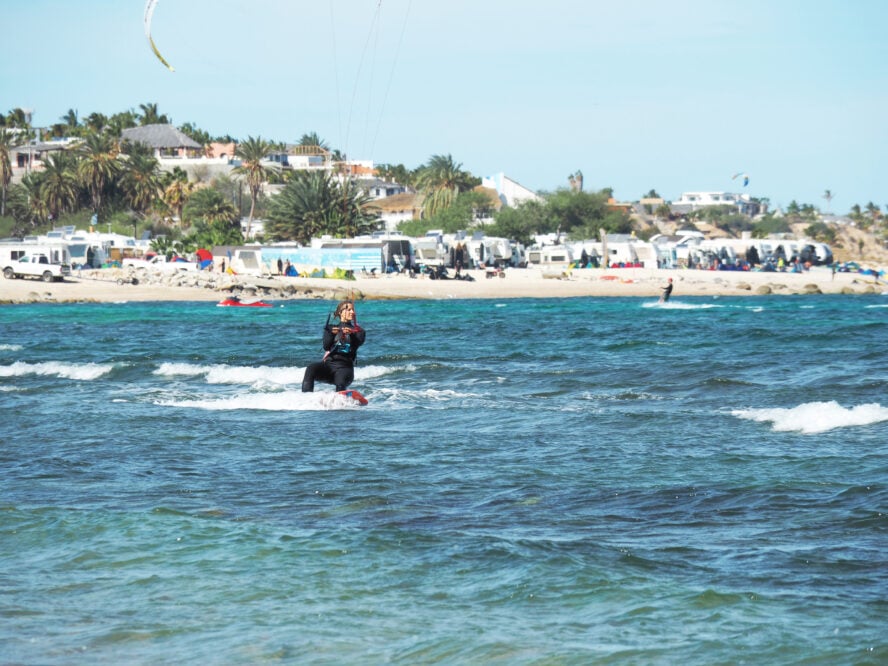
La Ventana is the perfect mix of ideal conditions and kitesurf culture
The nature in La Ventana is quite unique with cactus forests, desert landscapes, bright beaches, deep, clear turquoise water, and a beautiful contrasting mountain chain that gifts kiters with an extra wind boost. The kite bay is huge and stretches all the way from El Sargento to La Ventana, making it an even better beginner spot than kiteboarding in NYC, as well as a spacious progression spot to practice your new tricks. Similar to Squamish kiteboarding, the wind is typically smooth and consistent, blowing in almost every afternoon between November and March.
There aren’t too many restaurants and cafes, but I still had enough choices during my 3-week stay. One of my favorite events was the Thursday Farmers Market, with fresh veggies, fruits, healthy homemade goods, and unique handcrafted souvenirs. I personally couldn’t get enough of the combination of morning yoga, kitesurfing, evening yoga, sunset beer at the beach — so I can highly recommend yoga at Baja Joe’s rooftop deck, Casa Verde or Casa Tara, they all have different classes with great teachers. I also met a lot of kitesurfers who explicitly came for the good mountain biking conditions, so there’s that option for the early mornings as well.
The alluring triple-hit of great wind, warm water and a welcoming, laidback community makes La Ventana a truly special place.
La Ventana - Good to Know
From beginner to advanced
November – March
Varying from 14–30 knots so bring all your kite sizes including a foil board if you have one
mostly choppy, some wind waves on stronger days
long wetsuit
Yoga, mountain biking, whale watching, road tripping, going surfing on the other side of Baja California
Mariscos el Cone for seafood, La Moringa for healthy food lovers
Visit Todos Santos and the famous “Hotel California” (and listen to that song on repeat on your way there)
Getting there
The quickest way to get to La Ventana is flying in to La Paz (LAP) and heading to La Ventana with a rental car. I’d recommend getting a rental car to explore more parts of Baja California and move around a bit. Often, you can find cheaper flights to Los Cabos (SJD), a 2.5 hour drive away from La Ventana by car.
3. Cape Town
When I heard my friend Crystal Veness’s words about Cape Town, I couldn’t have found a better introduction to this world-famous but also extreme kitesurf spot: “The scenery will steal your heart and the wind will knock you off your feet. It sounds pretty intense – and it is, in all the best ways.”
Although it’s famous for hosting some of the best surfing in the world, I only started acknowledging Cape Town as a great kite spot on my second visit, after eight years of kitesurfing already. Similar to the kiteboarding in Cape Verde, the conditions are rough and can get very extreme, so it’s only for intermediate to advanced kitesurfers who can deal with the big waves and strong winds.
Cape Town is the winter destination for kitesurfing
That being said, Cape Town has a very special kind of magic: the long white sandy beaches, iconic Table Mountain covered with clouds, bright skies, the warm summer air and cold water. In the Blouberg area where all the kitesurfing happens, which is a 30-minute drive from Cape Town Center (with no traffic), you’ll bump into pretty much all the kitesurf pros on a daily basis as it’s the one and only winter destination. Sunset sessions are magical, days are long (especially if you come from the European winter), the food is amazing and wine tasting should definitely be on your to-do-list, along with hiking (or taking the cable car) up Table Mountain.

Cape Town is a spot for advanced kiteboarders
While I love strong winds and extreme conditions I became very humble in Cape Town and this is one of the spots where it’s good to keep a healthy respect for the ocean and your skills. 16 knots in Cape Town are way different from 16 knots in the Caribbean as the wind in Cape Town has a different wind density.
In Blouberg, you’ll usually you will have a few days of wind, followed by a few days of no wind, so it is advisable to check the wind at surrounding spots like Langebaan (flat water lagoon), Hermanus (flatwater and waves) as well as other spots with different wind directions for different levels. Here is my detailed guide on which surrounding spot are best with which wind direction.
Challenge yourself to a downwinder
Downwinders are a must for the experienced riders and the best way to escape the crowds that stay at the main spots in the Blouberg area. My favorite one is from Dolphin Beach to Big Bay (a short one) or continuing all the way down to Haagkat. If you get yourself a bus card, you can take the MyCiti bus back to your launch point, or take a dry bag with some clothes, brush all the sand off, and Uber your way back.
There’s something special about Cape Town. The energy, the vibes, the people, I can’t get enough of this place. The strong wind and big kicker waves provide perfect conditions for extreme kitesurfing.
Quote by Hannah Whiteley, professional kitesurfer and extreme sports athlete, 2017 Kitesurf World Champion
Cape Town - Good to Know
Experienced intermediate to advanced riders, mainly for wave riders and big air riders
December – February
16–50 knots (getting stronger and stronger throughout the day); average of 30 knots
Small to massive waves, choppy, flatwater in Langebaan
Minimum 3/2, better a 4/3 wetsuit
Hiking/climbing, wine tasting, safari, surfing in Big Bay, visit the penguins, exploring the city of Cape Town, go to one of the many concerts happening outdoors
“King of the Air” happens at the end of January/beginning of February
Getting there
Cape Town Airport (CPT) is about a one hour drive (depending on rush hour traffic) from the Blouberg area, the center of all the kitesurfing action. You can either get your own rental car (which makes sense if you want to make use of the no wind days and explore the surrounding areas) or Uber your way around Blouberg and the Cape Town area.
4. Le Morne
Le Morne, Mauritius has been one of the spots which has been on my bucket list for quite some time, but I always labeled it as a wave destination for advanced riders. But then I found out that it also has a huge flat water lagoon and plenty of space for non-wave riders inside of the reef, as well as easy wave spots next to those world famous barrels.
Mauritius is a place of epic beauty
The nature in Mauritius is breathtaking: next to the incredible ocean life you have rich green nature and mountains, beautiful waterfalls and endless beaches with turquoise water. The first time I was kiting here it was hard to focus on kitesurfing itself; I couldn’t get my eyes off the water colors, the reefs and corals I was gliding over, and the scenic Le Morne Brabant Mountain in the back. Not to mention the spectacular natural phenomenon and optical illusion — underwater waterfalls — are happening right underneath your feet. The underwater currents that create this spectacular view are also one of the aspects that make this spot and the waves only suitable for experienced kitesurfers.

A mix of cultures and culinary options
Mauritius itself is a colorful mix of cultures, nationalities and religions that exist peacefully alongside and with each other — which also shows in their diverse culinary options. Because of this cultural diversity, the island is also often called “Rainbow Paradise Island.” This also shows in the languages that are used in Mauritius – there is no official language: English is used for written government and administrative work, French is used in the press (which you’ll also hear on the radio), and the majority of people also speak Creole. You will get along quite easily with speaking English.
Where to stay in Mauritius
I stayed in an apartment in La Gaulette (10 min drive from the spot) where most kitesurfers stay. There are a few restaurants, kite shops and a big supermarket. If you want to stay in one of the big resorts right at the spot, you can either stay at ION Club or RIU Le Morne.
Le Morne is challenging, breath-taking and a tad prestigious. The reliable trade wind gets accelerated by the imposing mountain offering everything from a huge flat water playground to the famous, fast and furious One Eye. No visit to this spot will ever disappoint, bringing many riders back year after year!
Quote by Aafke Gulickx, kitesurfer and digital nomad who keeps coming back every year to Le Morne
Le Morne - Good to Know
From beginners to advanced, main attraction is for advanced wave riders
May – September
15–35 knots, bring all your kite sizes but be prepared to use your smaller sizes
Flatwater and chop in the lagoon; chop and waves at the point and reefs
Long wetsuit, or if you don’t get cold easily, shorty
Climbing/hiking Le Morne Brabant Mountain, surf/SUP (be aware of the current!), dolphin watching, visit one of the many spectacular waterfalls, go rum or lychee wine tasting
The fruit stand at “The Point” for sunset with a fresh coconut in your hand
Hike or climb Le Mourne Brabant Mountain
Getting there
The Airport Sir Seewoosagur Ramgoolam (MRU) is about a one hour and 15 minute drive from Le Morne or La Gaulette. You can either get your own rental car, which I’d recommend as there is so much to explore on the island (left-hand driving!), or arrange transport with your accommodation.
5. Jericoacoara
While I absolutely love the whole northern coast of Brazil due to the wind guarantee, warm water (say hello to kiting in a bikini/boardshort) and endless sandy beaches with just as many downwinder options, the former hippie village of Jericoacoara has a very special atmosphere. The whole village is located inside a National Park and you will only find sandy roads. If you come during the windy season, you can literally kite all day long.
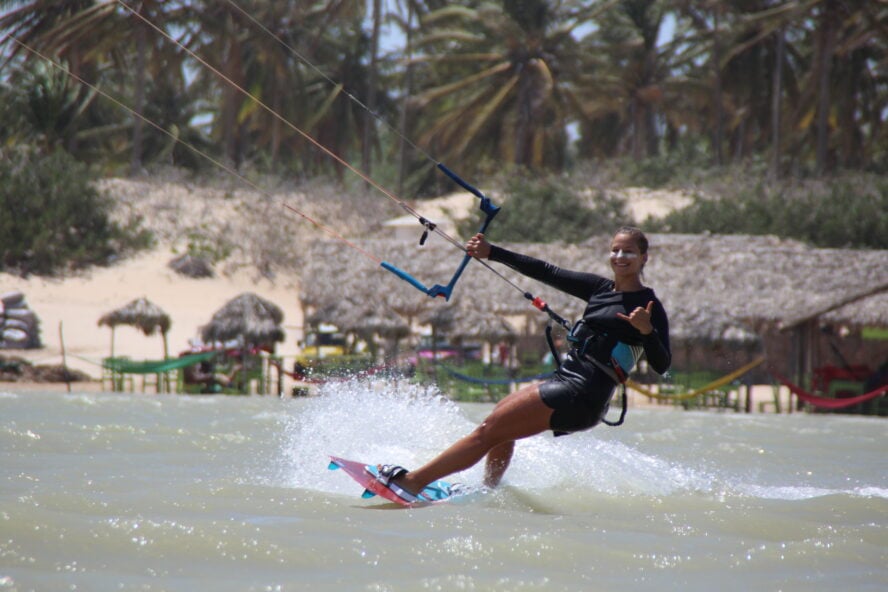
Jericoacoara is a downwinder’s paradise
Downwind possibilities here are endless! We’d often take a buggy up to Prea, kite all day, have a delicious lunch at Rancho do Peixe, and do a downwinder back to Jeri before the sun set. Another great option is to start your downwinder behind the dune in Jeri (best for intermediate kitesurfers) and make your way down to the Guriu lagoon. There you can kite in the flatwater (high tide only), have a cold coconut, and if you’re up for a big downwinder, continue to Tatajuba lagoon. There are plenty of other downwind options if you want to kite longer. You rent a buggy or 4×4 and hire a local driver to go wherever your heart desires.
If you are up for an adventure trip, I recommend getting your own rental car and making your way from Cumbuco (which is close to Fortaleza airport) to Jericoacoara. If you have more time, head even further up to Barra Grande and Macapa. There are so many spots along the coast that it’s hard to pick just one! This coast was made for downwinding which is why there are many tour operators offering daily downwinders — or weekly ones up the whole coast.
Come for the kiting, stay for the Caipirinha
Unlike other kite spots along the Northern Coast, Jeri has the most infrastructure, with plenty of good restaurants, shops, kite schools, the famous Caipi Street — a “street” formed by food stands and little Caipi stands with endless Caipi variations — and, the big dune. The dune is where every evening people walk up, Caipi stands are pushed up through the sand and people marvel at the sunset with an ice-cold drink in their hand, clapping when the sun plunges into the ocean.
Accomodation options for for all budgets
Jeri offers accommodation for every budget — from hostels with dorms (great for solo-travellers) to luxurious hotels. It costs extra to get take a buggy every day to the kite spot, so if you prefer staying right where the action is, Prea is a better option.
Jeri is the only place where you don't wait for the wind, rather the wind waits for you! Every single day from July until the end of the year, 11am - 6pm, it's 6m kite weather! … 600km of perfectly kiteable conditions, plus lagoons!
Quote by Tijana Momirov, windsurfer and kitesurfer who moved from Europe to Jeri
Jericoacoara - Good to Know
Intermediate to advanced (but there are spots for beginners to learn)
July – December
25–30+ knots so bring your small kites (the wind is strongest in November)
Mostly choppy; flatwater in the lagoons; some wind waves
Bikini/boardshort and a rashguard for sun protection
Surfing, shopping and buggy tours. Or you can chill on the beach and try all the Caipi variations
Sunset Caipi on the Dune or on “Caipi street”
Lunch buffet at Club Ventos (come before 1.30pm to get the best of the buffet); dinner in the fairytale-like “Na Casa Dela” or Peixe Brasileiro for seafood
There are no cash machines in Jeri, so make sure you get cash at the airport or surrounding villages before you arrive
Getting there
There are several ways to reach Jeri: fly to i Fortaleza (FOR), and from there you can either fly to the national airport of Jijoca of Jericoacoara (JJD) or get a private transfer via 4×4 ( a 4.5 hour drive). The cheapest but longest way to get there is by bus. This takes about 7 to 8 hours, with a stop in Jijoca. You can also rent a car if you want to explore more of the coast as you make your way to Jericoacoara, but you’ll need a driver in Jijoca to help you make it through the dunes. If you do drive to Jericoacoara, you’ll have to park outside of town in the large lot. Another option is to stay in Prea which is accessible by car and much more quiet. From Prea, you can hire a buggy to get to Jeri.
6. Isla Verde
Known as the “Maui of the Caribbean,” Puerto Rico is the smallest and easternmost island of the Greater Antilles and an unincorporated territory of the USA. While Puerto Rico doesn’t have as consistent trade winds as the rest of the Caribbean, it’s worth the visit because it’s easy to reach, has warm weather all-year-round, beautiful turquoise water, and you’ll find both calm water and big waves.
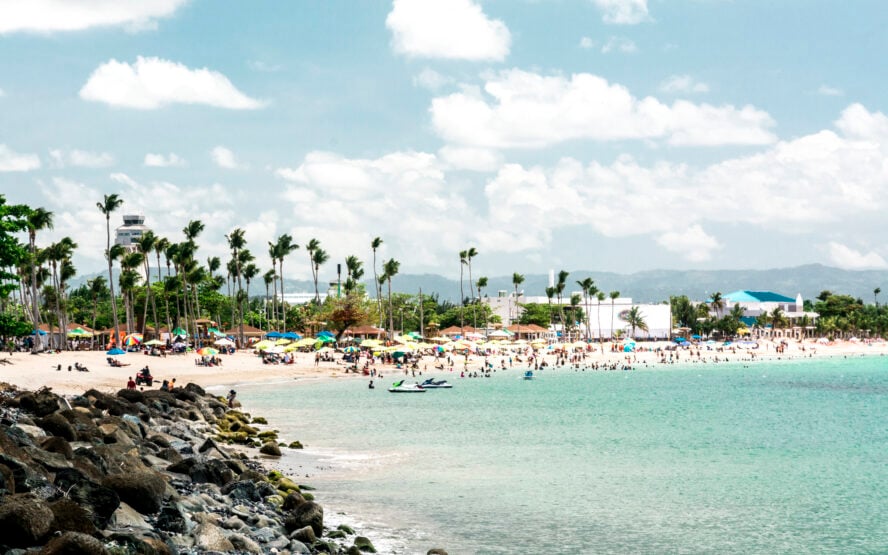
Isla Verde is Puerto Rico’s best kitesurfing spot
Puerto Rico offers a great combination of resorts, hotels, city life and kitesurfing, in the big bay and wide beach of Isla Verde. Conditions with side-shore wind in Isla Verde are ideal for all skill levels of kiteboarder. The water conditions are choppy in the winter and flat to small chop during the summer.
The capital, San Juan, is undisputedly one of the highlights of the island. Its nightlife is unparalleled in the Caribbean, so if you have some energy left after kitesurfing, you can dance your heart out in one of the clubs until dawn.
We have beautiful flat water spots that are great for freestyle tricks and cruising and we also have great wave riding in the north of the island, which is possible due to Puerto Rico’s geographic position in the Caribbean and exposure to cold fronts that come down from North America.
Quote by Karla Barrera, Olympic Windsurfer in 2004 and owner of the Goodwinds Water Sport Center in Dorado Beach
Isla Verde - Good to Know
From beginner to advanced, depending on the season
Jan – Feb (Dec, Mar, Apr can be ok) larger waves for experienced kitesurfers but more inconsistent wind; Jun – Jul (Aug can be ok) water is more flat, steadier but weaker wind
Jan – Feb has more inconsistent wind (ranging from 10–25 knots); Jul – Sep has more stable but weaker wind (12–18 knots)
Choppy, waves on the reef
Bikini/boardshort, rashguard for sun protection
Surfing, hiking, snorkeling/diving, exploring caves and bioluminescent waters, party/dance in San Juan
Explore one of the bioluminescent bays
Getting there
Arriving at San Juan Luis Muñoz Marín Airport (SJU), you get to Isla Verde within a 5 to 10 minute taxi drive (depending on traffic). There is a set fee for this route.
7. Boca Grandi
Aruba is also called “One Happy Island,” and while I haven’t made it there yet, it’s always been on top of my kitesurf bucket list. The locals are friendly, life is laid-back and easy, the weather is warm all year round, and the wind statistics will make your kite heart jump higher! As Aruba is a luxury-travel destination prices are higher, but there are all kinds of different accommodations.
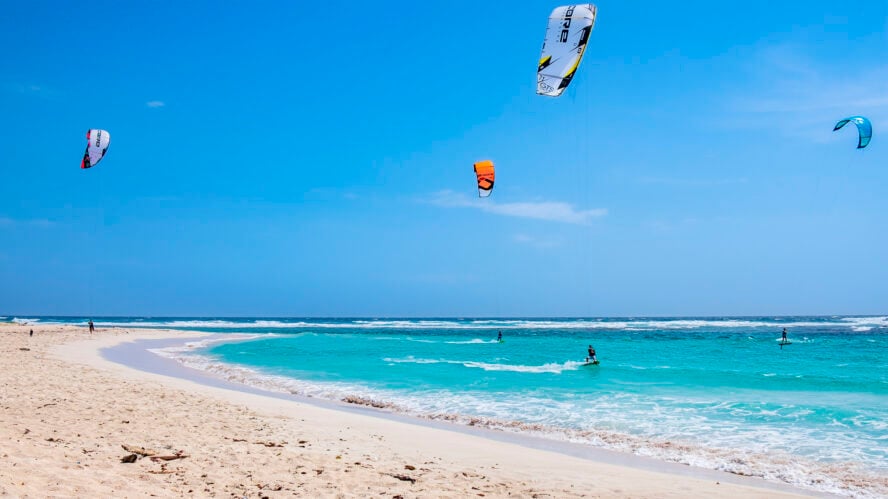
The wind is stable in Boca Grandi (and it’s not overcrowded)
Boca Grandi is an absolute beauty with its white dunes, lush, green vegetation, and crystal-clear turquoise water. I can’t wait to shoot some pictures when I finally visit. The bay itself doesn’t have any infrastructure, so bring your own water and food. Unlike the other spots on the island with off-shore wind (and because of gusty yet flat conditions) Boca Grandi has super stable wind due to the onshore wind that hits this 700m-wide bay. The bay is a bit protected from the reef but conditions are still rougher than other spots. You’ll mainly spot locals kiting in the early morning or evening. There are some places to stay close to Boca Grandi, restaurants and shops are farther away than if you stay elsewhere.
I thought the bluest water I have ever seen was in the islands surrounding Thailand and in Zanzibar. But after I went far out into the sea at Boca Grandi, I now know this is by far the most beautiful blue water I have ever come across!
Quote by Michelly Sky Hayward, kitesurfer, traveller and writer
Boca Grandi - Good to Know
Intermediate to advanced
Jan – Aug (Sep, Nov, Dec are good as well, but with a bit lighter wind)
16–25 knots. You will use smaller kite sizes more during the main windy season; bring bigger kites for off season
Choppy, smaller waves in between, medium waves (up to 2m) on the reef
Bikini/boardshort, rashguard for sun protection
Dive, snorkel, SUP, sail, golf, hike in Arikok National Park, Jeep safaris, shopping
Getting there
Reina Beatrix (AUA) is a 25-minute car ride away from Boca Grandi. Rent a car (I recommend a 4×4) to get from your accommodation to the kite spot and to explore the island.
8. Isla Blanca, Cancun
When I fell in love with the laid-back vibe and the amazing food in La Ventana, I asked around about other spots that I should visit in Mexico. Isla Blanca was repeatedly recommended. It’s a natural paradise, with hip-deep flatwater just a 25-minute drive from Cancun. Isla Blanca works well with any wind direction and if you ever get bored of the flat, you can switch to the ocean side. The nature reserve in Isla Blanca combined with Cancun’s city vibes and nightlife make an ideal combination of pure kitesurfing, Mexican food and nightlife.
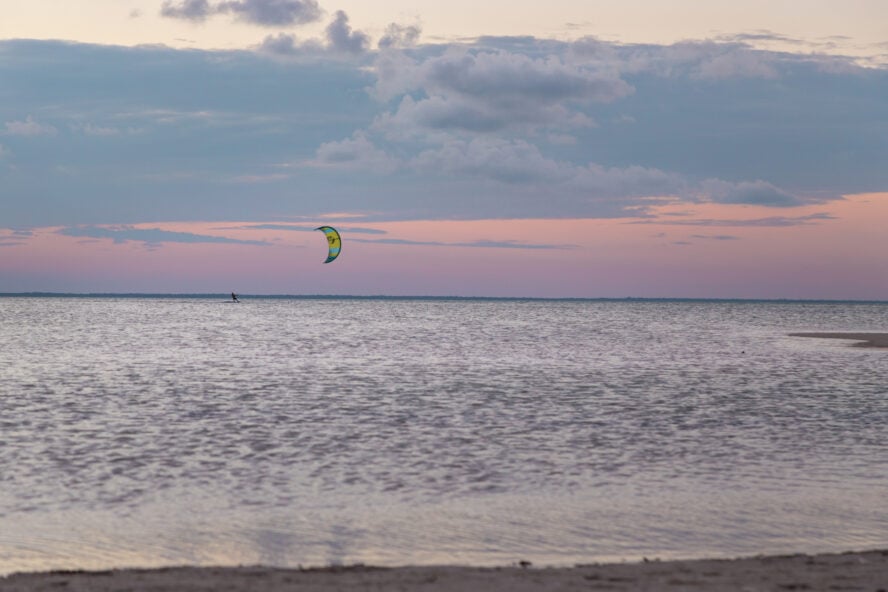
The best spots in Isla Blanca depend on the wind direction
Depending on the wind direction, different spots work better than others: with N or NE wind,the Ikarus Kite Camp offers butterflat water; La Punta is viable with every direction, but with E or SE wind (offshore) the water becomes butterflat for learning new tricks and freestyling.
Where to stay
You can stay right in Isla Blanca at the campground or in the kite center. You can also make the daily commute if you prefer staying in one of the bigger hotels in Cancun. For intermediate to advanced kiters who want to stay close to Cancun, you can explore locations in the Cancun Hotel Zone like Playa Delfines (N, E, SE wind, choppy with some waves, shorebreak), Playa Chac Mool (N, E, SE wind, choppy, some waves) and Punta Nizuc (E and SE wind, flat or choppy with stronger wind).
A 10-mile strip of protected land extends away from Cancun, with the ocean on one side and miles of waist-deep, butter flat water on the other. This, combined with white sand, consistent winds, turquoise water and the most incredible birds will take your breath away
Quote by Rose Bungener, kitesurfer and adventure addict
Isla Blanca, Cancun - Good to Know
Beginners to advanced
November – June
November – April around 18–25 knots; April – June around 10–20 knots
Butterflat, choppy, small waves on the ocean side
Nov – Apr 4/3 for winter; Apr – June bikini/boardshorts
SUP or kayak in Isla Blanca, wildlife watching, explore Cancun, visit the Mayan ruins, go whale watching in summer, take a boat tour and dive/snorkel on Isla Mujeres or Isla Contoy
Getting there
Fly into Cancun International Airport (CUN) and ideally take a rental car (or taxi/pre-arranged transfer) to the Hotel Zone (25 minutes) if you want to stay close to Cancun or directly to Isla Blanca (50 minutes from the airport, 25 minutes from the Hotel Zone).
9. Turks & Caicos
Another spot that’s on the top of my kitesurf bucket list! The Turks and Caicos Islands (TCI) consists of the main island, Providenciales, and the various Caicos Islands. Turks and Caicos is famous for their beautiful turquoise water and marvelous beaches. The kite beaches feature shallow, warm water year-round, and white sandy beaches paired with constant Caribbean trade winds. What else could you possibly need?

Provo has conditions for all skill levels
The main spot for kitesurfing is on Providenciales (or Provo as locals like to call it): the 4km-long Long Bay. The onshore or side-onshore easterly trade wind makes it safe to kite here for all skill levels, thanks to the big shallow standing area that goes almost 2km into the water. If you want the best combination of wind and waves, then the winter months, specifically February and March, are best.
Spots for more advanced riders
There are also tons of other spots for more advanced riders: there are butterflat sections around Emerald Point with some nice waves on the reef in the winter months; Grace Bay (with northeast wind) has choppier water and amazing waves on the barrier reef; also check out Turtle Tail with butterflat water or Kite Safaris on the North and Middle Caicos islands.
Where to stay and how to get around
Taxis are overpriced even for short distances, so it makes sense to rent a car to explore the island and surrounding spots. There are a lot of luxury accomodations, so your best chance to find more affordable accommodation is on sites like Airbnb. You can stay close to the Long Bay area or the main tourist areas of Grace Bay and Leeward, which are just a 5-minute drive from Long Bay.
The main island of Providenciales is home to a spot with world-class learning conditions, along with many quiet and secluded beaches to explore. It is no surprise that several brands have shot promotional videos in these picturesque islands.
Quote by Nik Ganderton, Providenciales local, kitesurfing instructor and kite photographer
Turks & Caicos - Good to Know
Beginner to advanced
Jan – April although you can kite hear year-round
10–25 knots, bring bigger kites; for foiling bring a shorter mast because of the reef
Long Bay is more flat during low tide and choppier with high tide. There are wave spots and flatwater spots for intermediate to advanced riders
Bikini/boardshorts weather. In the winter you can wear a shorty if you get cold
Fishing, sailing, SUP, kayak, snorkel, dive, surf, horse riding, wakeboarding behind a boat, relaxing on the beach
Visit the iconic shipwreck by kite
Getting there
Providenciales, Turks and Caicos (PLS) is a 20-minute drive away from Long Bay or Grace Bay.
10. Phuket
With its white sandy beaches, light blue sea, and majestic coconut palms, Thailand’s tropical paradise is undoubtedly one of the most popular holiday islands in the world. While I haven’t kitesurfed when visiting Phuket, the sight of kitesurfers on the beach has always lingered in my mind. Phuket is quite touristy, with numerous resorts, restaurants and hotels, so your non-kitesurfing travel partners will find plenty to do while you’re out on the water.

Kitesurfing at Chalong and Friendship Beach
Phuket has two seasons, and the kitesurf scene moves accordingly to the wind to the two main spots of the island. From December until February, during the dry, hot season, which is also Phuket’s high season, the spot to be is Chalong or Friendship Beach in the southeast. The bay is protected from big waves and the waist-deep water makes it an ideal spot for kitesurf beginners.
Kitesurfing at Nai Yang Beach
From June until September – during the low, wet season – kitesurfing happens in Nai Yang beach, which is located in a national park in the northeast part of the island, just a 5-minute drive from the airport. The flat and waist-deep water makes it suitable for beginners, and the beautiful sandy beach is lined with coconut trees. With stronger wind, advanced riders and wave lovers can find some good waves out on the two reefs. During the wet season, look out for short, tropical rain showers, which usually last 30 to 60 minute — not a big deal because they bring the good winds!
Not only does Phuket have some of the best surfing in Thailand, it’s also got some pretty sweet kitesurfing conditions when the season is on.
Quote by Grace Austin, one half of the Extreme Nomads team, world traveling kitesurfer and adventure sports addict
Phuket - Good to Know
Beginners to advanced
December – February, June – September
Average 15 knots in winter, around 20 knots in summer
Flat and shallow, some wind swell out in the bay
Bikini/boardshort, rashguard for sun protection
Diving, snorkeling, golfing, Muay Thai, partying in Patong, surfing (Apr – Oct)
Getting there
The easiest way to get to Chalong and Nai Yang is by flying to Phuket International Airport (HKT), with a probable a stopover in Bangkok depending on your flight connection. From the airport to Chalong beach is a 1-hour drive; to Nai Yang beach it’s a 5-minute drive.



